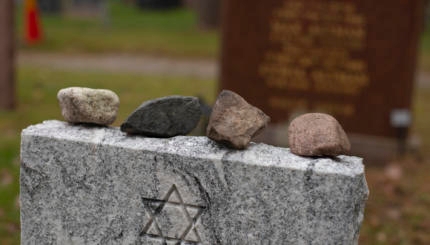Reprinted with permission from The Torah: A Women’s Commentary, edited by Tamara Cohn Eskenazi and Andrea L. Weiss (New York: URJ Press and Women of Reform Judaism, 2008).
There is power in taking a census. When God commands Moses to do so at the beginning of Parashat B’midbar, only male Israelites over the age of 20 who are able to bear arms are considered. In the text, Moses is told to tally up kol adat b’nei yisrael, literally “the whole community of the Children of Israel.” But do able-bodied males over 20 years old represent the whole community? While adat is often translated as “community,” it can also refer to an “assembly, band, company, or faction,” hence only one segment of the larger population. This nuance allows us to recognize all who are not counted: women, minors, the elderly, and the physically, mentally, or emotionally challenged.
In Torah, these people are usually missing from numerations as well as narrations. Those who are counted have a special worth to the society, while those who are not may be considered less valuable and are, therefore, less visible.
The Danger in Taking a Census
There is also danger in taking a census. This parashah is all about enumerating people, as the English name of the book, “Numbers,” suggests. However, the Talmud asserts that “it is forbidden to count [the nation of] Israel even for the sake of a commandment … [because] whoever counts Israel transgresses a prohibition, as it is written, ‘The number of the children of Israel shall be like the sands of the sea, not to be measured’ (Hosea 2:1)” (BT Yoma 22b).
Rashi explains that we must count something each person gives (like the half-shekel) rather than count actual people, because then “there will not be a plague among them, for the evil eye can affect that which is counted–and a plague may come upon them as we found in the days of David” (Rashi on Exodus 30:1). Is Rashi merely superstitious, or is he suggesting that it is dangerous to trivialize a person’s essence? His comment teaches us that we must value each human as one who is made b’tzelem Elohim; in God’s image (Genesis 1:27). A number can measure whether an army has enough people, but it can never measure the worth of the individual people in that army.
Making Everyone Count
Today, American society is obsessed with numbers, censuses, and demographic studies. Now when we calculate our Temple membership, for instance, we include everybody: the women and the men, the young and the old, the “typical” and the challenged. We can look at sum totals, categories, and sub-categories of these studies; and while they provide valuable information, they still may not show us who or what really counts. Can we say that all people matter when our Jewish institutions are not accessible to every individual?
Taking the synagogue as an example, do we value each person when a member in a wheelchair cannot come up to the Ark to take the Torah? Do we include everyone in worship services when we do not offer large-print prayer books or when we do not provide hearing aids to those who need them? Do we validate those with different learning styles and abilities when we hire inexperienced educators for our Religious School classes? If we compare our raw data with the facts within the synagogue walls, who really matters-the ones who are counted, or the ones for whom we take extra measures? While numbers may be essential, they do not represent the sum total of what is truly important. But what does?
In B’midbar, one could argue that the number of troops is what really counts, since they are the ones included in the census. But when we read between the lines, when we ask who is not included, we can see how the untold stories of the unmentioned people matter too. For instance, what about the woman who might have wished to fight? Or how about the 19-year-old man, just months short of his 20th birthday, eager to serve God and his people? And how about the 23-year-old male Israelite who can count the right number of years but not the right number of limbs since one of his was lost in a childhood accident? And the pregnant soldier’s wife who calculates the number of weeks until her baby arrives, knowing that the baby’s father’s days may be numbered?
There may be contextually legitimate reasons why these people are omitted from the census, and, ultimately, from the Torah text, but their exclusion means we miss the opportunity to see what they can offer the community.
Gaining From Loss
We all hear stories about those who lose one thing and gain something even greater through their loss. There is an urban legend about violin virtuoso Itzhak Perlman, who taught that lesson by happenstance when he played a concerto at Avery Fisher Hall in New York City with a broken string. One might think it impossible to play with just three strings a concerto written for violin, but Perlman did it and did so with great fervor. Upon completing his dazzling performance, he (so the story goes) said humbly to the audience, “You know, sometimes it is the artist’s task to find out how much music you can still make with what you have left.” Perhaps this is true for all of us, not only artists. Losses can lead to inner strengths and life changes that we did not dream were possible. We are more than the sum total of our parts.
The Israelites may have needed parameters for whom to include and whom to exclude from the census described in B’midbar, but we must remember why even those not tallied do, in fact, matter. Today we may count every individual in our community, but may still discount how much they have to offer. The missing members in this parashah can teach us to reconsider what it means to count. As the numerous stories in the Bible and in our lives remind us, even those not included are important, and all those we now seek to include genuinely are individuals with much to gain from and offer to our communities.
The product of fourteen years of work and the contributions of more than 100 scholars, theologians, poets, and rabbis—all of them women—The Torah: A Women’s Commentary is a landmark achievement in biblical scholarship and an essential resource for the study of the Bible. For more information or to order a copy, visit URJBooksandMusic.com.
Talmud
Pronounced: TALL-mud, Origin: Hebrew, the set of teachings and commentaries on the Torah that form the basis for Jewish law. Comprised of the Mishnah and the Gemara, it contains the opinions of thousands of rabbis from different periods in Jewish history.
Torah
Pronunced: TORE-uh, Origin: Hebrew, the Five Books of Moses.


